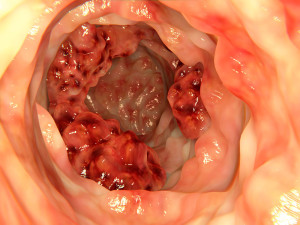Introduction
I have summarized information on colon cancer in a shorter chapter as part of the differential diagnosis of abdominal pain. Here I will discuss colon cancer in more detail. Colon and rectal cancer are common cancers in the Western civilized countries. In the U.S. they make up about 15% of all cancers. About 150,000 new cases are diagnosed every year and 75,000 die every year from this disease.
From the age of 35 to 40 years onwards there is a steep increase until the age of 80 years when the incidence curve flattens out. Studies have lead to a broad knowledge base regarding the questions of why colon cancer develops, how to diagnose it early, some genetic markers, whom to screen and what diet to eat to minimize the risk of developing it (Ref. 1 and 2).
Familial polyposis
When high colon risk families were studied, it was learnt that the highest risk for colon cancer is in families with familial polyposis, where literally hundreds of colon polyps are growing on the lining of the colon because of a genetic flaw. Each of these polyps has a stalk, which is attached to the lining of the rectum or colon. On top of the stalk is a fleshy little mushroom like polyp, in which changes take place that lead to cancerous degeneration.
At this stage the new cancer focus is born. From here onwards new growth is happening with a spread inside the polyp mass, then invading into the stalk, next invading the base of the stalk, which is the rectum or colon at large.
Colonoscopies with polypectomies reduce colon cancer risk
Armed with this knowledge gastroenterologists started to treat the polyps, which originally were thought to be harmless, and removed them. It was learnt that the cancer rate could be reduced drastically this way. Even in some families where less polyps occurred, complete cancer prevention of the rectum and colon was possible. Not all cancers of the rectum and colon are developing out of polyps, but 85% do. The other ones develop directly from the lining of the rectum or colon itself or develop within the muscle of the rectal or colonic wall. The fact that 85% of all cancers of the rectum and colon, even in those without family history of familial polyposis, develop out of polyps has important implications for colon cancer screening.
Prevention of colorectal cancer
Gastroenterologist Dr. Stephen O’Keefe of the University of Pittsburgh School of Medicine did an interesting experiment. He took 20 black men in the US and 20 in rural South Africa and did a diet swap: the South Africans were fed fast food, a diet high in fat with generous quantities of meat and cheese (fried chicken, burgers and fries). The black Americans in the US were fed a rural South African diet, high in fiber and low in fat; it contained beans and cornmeal, plenty of fruit, vegetables and very little meat.
Butyrate correlates with colon cancer frequency
Both groups underwent extensive testing including a colonoscopy, analysis of the bowel flora, measurement of a chemical called butyrate, which protects against colon cancer and screening for inflammation. After only two weeks there was inflammation in the colon from the fast food in the South Africans, butyrate was down and the bowel flora was abnormal. The American blacks had no inflammation in the colon and rectum, the bowel flora was normal and butyrate levels were high.
This study shows how important it is to switch to the right diet, a diet full of fiber, protective lycopenes and absent junk foods.
References
1. Cancer: Principles &Practice of Oncology, 4th edition, by V.T. De Vita,Jr.,et. al J.B. LippincottCo.,Philadelphia, 1993.Vol1. Chapter on Cancer of the colon.
2. Cancer: Principles&Practice of Oncology. 5th edition, volume 1. Edited by Vincent T. DeVita, Jr. et al. Lippincott-Raven Publ., Philadelphia,PA, 1997. Chapter 32, Section 7: Cancer of the colon.
3. The Merck Manual, 7th edition, by M. H. Beers et al., Whitehouse Station, N.J., 1999. Chapter 34, page 328-330.
4. S Srivastava et al. Clin Cancer Res 2001 May;7(5):1118-1126.
5. RF Holcombe et al. Cancer Detect Prev 2001;25(2):183-191.
6. S Kinuya et al. J Nucl Med 2001 Apr;42(4):596-600.
7. D Chen et al. IEEE Trans Med Imaging 2000 Dec;19(12):1220-1226.
8. B. Sears: “The age-free zone”.Regan Books, Harper Collins, 2000.







